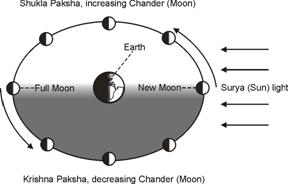Universe
As per centuries old Vedas (holy scriptures) there are infinite Bhramanda (Universe). This fact was directly revealed to the Sages (Seers) in their deep meditation. In that Yuga (era), Sages (seers) did not have the physical devices to explore the vast Universe. Now modern astronomers have also learned that there are approximately tens of billions of galaxies in this Universe, each with billions of stars and probably many planets as well!
When you look up at the sky, you are looking at the tiny portion of our Universe. Stars, which we see in the night, belongs to our home galaxy, called Milky Way. Middle part of this disk is called Nucleus. Milky Way galaxy is about 80,000 light years accros with about 200 billion stars. Because of Earth's own rotation, all stars except Dhruva Tara (Pole Star or Polaris or North star), changes their positions during the course of night. Dhruva Tara (Pole Star or Polaris or North star) is situated in the North of Earth and that's where it stays.
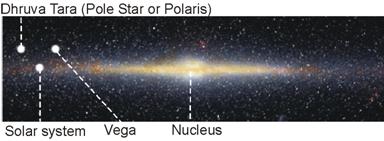
Fig. 3.1 : Milky Way - side view
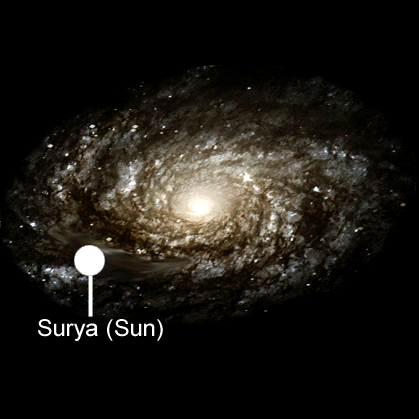
Fig. 3.2 : Milky Way top view
Our Universe is big in time as well as space. Many stars are millions of light years away. When you are looking at them, you are actually looking back in the time, because light from these stars takes thousands to million years to reach us. Our Hubble telescope images show dozens of galaxies that are 10 to 12 billion light years from Earth. In other words, we see them as they looked 10 to 12 billion years ago. We see the things, which may not be there now!
Our Earth is located out towards the edge of this disk shaped galaxy. That’s why from Earth, we can see this disk from side. Surya (Sun) is approximately 30,000 light years from Nucleus (the center of Milky Way galaxy).
Solar system
In this Milky Way, we have our solar system, consisting of Surya (Sun), Budha (Mercury), Shukar (Venus), Earth, Chander (Moon), Mangal (Mars), Bhraspati (Jupiter), Shani (Satrun), Rahu (ascending node or dragon head) and Ketu (descending node or dragon tail).
As per Vedic Jyotish (astrology), only 9 Grahas (planets) receive spiritual energy from the Universe and transmit it back on to Earth. Surya (Sun) is at the center, and rest of the 9 Grahas (planets) move around Surya (Sun) in their own elliptical orbit. Chander (Moon) revolves around Earth too. These Grahas (planets) move within about 18-degree wide band, which again looks like a disk. Refer to fig. 3.3 heliocentric disc.
Rahu (ascending node or dragon head) and Ketu (descending node or dragon tail) are shadow planets, which are basically strong gravitational points. These two points are 180 degree apart and are formed when orbit of Chander (Moon) intersects the apparent orbit of the Surya (Sun) around Earth. Rahu (ascending node or dragon head) and Ketu (descending node or dragon tail) are always 180 degree apart i.e. they are always placed in the seventh Bhavas (arbitrary division of space around Earth) from each other i.e. facing each other.
These planets have different size orbits and revolve around the Surya (Sun) at different speed. For example, in the time that it takes Guru (Jupiter) to make a single orbit around the Surya (Sun), Earth will complete 12 orbits.
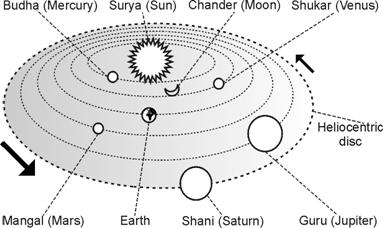
Fig. 3.3 : Heliocentric disc
This means that the planets constantly appear in different places in the sky in relation to each other. From Earth’s perspective, Dhruva Tara (Pole Star or Polaris or North star) is fixed in the north. Refer to fig 3.6 : Earth wobble motion.
Sequence and relative size of Graha
Next is the relative size and sequence of Graha (planet), from left to right i.e. Surya (Sun), Budha (Mercury), Shukar (Venus), Earth, Chander (Moon), Mangal (Mars), Guru (Jupiter) and Shani (Saturn) respectively. Surya (Sun) diameter is 865,000 miles and 109 times larger than Earth and 9.7 times larger than largest planet, Guru (Jupiter). Refer to fig 3.4 : Sequence and relative size of Garaha.
In this sequence, Chander (Moon) is an exception because it can be on the either side of Earth. Mangal (Mars), Guru (Jupiter) and Shani (Saturn) are called outer Grahas (planets), as in sequence they fall after Earth, whereas Budha (Mercury) and Shukar (Venus) are inner planets. Outer and inner Grahas (planets) are considered to be superior and inferior respectively.

Fig 3.4 : Sequence and relative Size of Garaha
Earth and it’s motions
In Vedic Jyotish (astrology), we are considering the effect of celestial bodies on an object, which is present on this Earth. Let’s understand Earth, its movemnets and relations with Surya (Sun) and Chander (Moon).
Earth is a spherical, like an orange, and tilted on its Axis. Axis is an imaginary line, which connects North and South Pole of the Earth. This is called Prime Meridian and is located at zero longitude.
Another horizontal line perpendicular to Prime Meridian, running from East to West is called Equator. Equator is located at the zero latitude and divides the Earth into two equal hemispheres i.e. North and South. Also, Earth is tilted at approximately 23 degree and 28 minutes to the plan of Equator.
Longitude and latitude are used to define a specific place on the Earth. Longitude has range from 0 degree to 180 degree either on East or West. One hour corresponds to 15 degrees of longitude and thus 360 degree represents about 24 hours. Refer to fig 3.5 : Earth.
City |
Longitude |
Lattitude |
|||
Degree |
Direction |
Degree |
Direction |
||
Houston, USA |
95W21’47 |
West |
29N45’47 |
North |
|
Delhi, India |
77E13’00 |
East |
28N40’00 |
North |
|

Fig 3.5 : Earth
Earth itself has three major distinct motions -
- Earth rotates on it's own axis from West to East and completes the rotation in 24 hours approximately. That’s why from Earth perspective it appears that celestial bodies are moving from East to West. Twelve Rashis (division of moving group of stars) and 9 Grahas (planets) appear to complete one full rotation of Earth in about 24 hours. In relation to Surya (Sun), Earth rotates in about 24 hours, which is called Mean Solar day. Whereas under a Sidereal day, Earth moves in relation to a fixed star, Earth takes 23 hours 56 minutes and 4.09 seconds. The difference is because by the time when Earth rotates once with reference to fixed star, the Surya (Sun) has also moved by approximately one degree, which takes additional 4 minutes each day.
- Earth moves in elliptical path around the Surya (Sun) and takes 365 days 5 hours 48 minutes 46 seconds. Refer to fig. 3.3 : Heliocentric disc.
- Earth wobbles because of gravitational pulls caused by Surya (Sun) and Chander (Moon). Because of this wobble, Earth's North Pole makes a wide circle, where as South Pole stays fixed and makes a shape of ice-cream cone. This motion takes about 25,870 years to complete. Because of this motion, Earth’s North Pole either points to Dhruva Tara (Pole Star or Polaris or North star) or Vegas. Refer to fig 3.5 : Earth wobble motion.
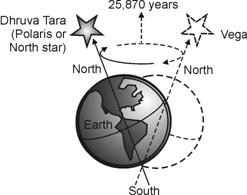
Fig 3.6 : Earth wobble motion
Moon
Chander (Moon) plays a key role In Vedic Jyotish (astrology). The way Earth moves around Surya (Sun), Chander (Moon) orbits around Earth. Chander’s (Moon) one rotation around the Earth make a one lunar month, which consist of ~27.32 days in Sidereal month (in relation to a fixed star). Again Chander’s (Moon) one cycle is divided into two parts viz Shukla (bright) and Krishna (dark) Paksha (side). Chander (Moon) considered strong and more benefic in Shukla Paksha (bright half). Refer to fig 3.7 : Moon phases.
| Day of Lunar month | Tithi (date) Name |
English |
Type |
Phases of Chander (Moon) |
1 |
Pratipat |
1st |
Aspicious |
Shukla Paksha : Increasing Chander (Moon), which leads to full Chander (Moon) on Purnima. |
2 |
Dvitiya |
2nd |
Aspicious |
|
3 |
Tritiya |
3rd |
Aspicious |
|
4 |
Chaturthi |
4th |
Aspicious |
|
5 |
Panchami |
5th |
Aspicious |
|
6 |
Sashti |
6th |
Aspicious |
|
7 |
Saptami |
7th |
Aspicious |
|
8 |
Astami |
8th |
Aspicious |
|
9 |
Navami |
9th |
Less aspicious |
|
10 |
Dasami |
10th |
Less aspicious |
|
11 |
Ekadasi |
11th |
Less aspicious |
|
12 |
Dvadasi |
12th |
Less aspicious |
|
13 |
Trayodasi |
13th |
Not aspicious |
|
14 |
Chodash |
14th |
Not aspicious |
|
15 |
Purnima |
15th |
Not aspicious |
16 |
Pratipat |
1st |
Not aspicious |
Krishna Paksha : Decreasing Chander (Moon), which leads to new Chander (Moon) on Amavasya. |
17 |
Dvitiya |
2nd |
Not aspicious |
|
18 |
Tritiya |
3rd |
Not aspicious |
|
19 |
Chaturthi |
4th |
Less aspicious |
|
20 |
Panchami |
5th |
Less aspicious |
|
21 |
Sashti |
6th |
Less aspicious |
|
22 |
Saptami |
7th |
Less aspicious |
|
23 |
Astami |
8th |
Aspicious |
|
24 |
Navami |
9th |
Aspicious |
|
25 |
Dasami |
10th |
Aspicious |
|
26 |
Ekadasi |
11th |
Aspicious |
|
27 |
Dvadasi |
12th |
Aspicious |
|
28 |
Trayodasi |
13th |
Aspicious |
|
29 |
Chodash |
14th |
Aspicious |
|
30 |
Amavasya |
15th |
Aspicious |
|
|
This completes one cycle of Chander (Moon), and then goes back to 1st day of lunar month i.e. Pratipat. |
|
||
Fig 3.7 : Moon phases
Eclipse
Surya (Sun), Chander (Moon) and Earth are not always in one line on every new Chander (Moon) day. This is because the orbit of Chander (Moon) is tilted at an angle of 5 degree. Whenever Surya (Sun), Chander (Moon) and Earth come in a straight line they cause eclipse. And to come in a line, Surya (Sun), Chander (Moon) and Rahu (ascending node or dragon head) / Ketu (descending node or dragon tail) should be close enough.
A lunar eclipse happens when Earth’s shadow falls accross the full Chander (Moon). During the eclipse, the Chander (Moon) passes through Earth’s outer shadow (Umbra), which is faint and not always visible, and then into the inner shadow (Penumbra), which is heavy and darkens the Chander (Moon) significantly. Dark inner shadow and is called Umbra, and lighter shadow is called Penumbra that spreads over a wide area. Refer to fig 3.8 : Lunar eclipse.

Fig 3.8 : Lunar eclipse
Solar eclipse happens when the new Chander (Moon) passes in perfect alignment between Earth and Surya (Sun), it throws two shadows viz a dark inner shadow called Umbra that comes to a point on Earth’s surface, and a lighter shadow called Penumbra that spreads over a wide area. Refer to fig 3.9 for solar eclipse. To experience a complete solar eclipse you must be in the spot on Earth where the Chander’s (Moon) inner shadow falls. If you are outside this area, but still within the outer shadow, you will see the partial solar eclipse.
Fig 3.9 : Solar eclipse
Equinoctial points
Because of Earth’s tilt Surya (Sun) appears to move back and forth across the equator from North to South hemisphere and vice versa. When Surya (Sun) moves towards North and crosses celestial equator is called the Vernal Equinox. It occurs around March 21st every year. When Sun moves towards South and crosses celestial equator is called the Autumnal Equinox. This occurs around September 23rd each year. Refer to fig 3.10 Celestial sphere.
These two different equinoctial points are different because of the wobble motion of Earth. In fact these equinoctial points change position in reference to fixed points in the space at the rate of 50.26 angular seconds per year.
In other words, every 25,870 years, the start point (i.e. Rashi Mesha (Aries)) will coincide with Rashi Mesha’s (Aries) start. Last time this happened in 285 AD and Ayanamsha (i.e. difference) was zero. System, which considers this shift, is known as Syana and others is called Niryana.
As of now this difference is about 23 degree, which causes the major difference in Western Astrology and Vedic Jyotish (astrology). This is because Vedic Jyotish (astrology) uses fixed Rashi (division of moving group of stars), which are based upon relatively fixed equinox because Thousands of Astrology rules are based upon these Rashis (division of moving group of stars). There are various rectification systems. Ayanamsha for 1990 was –
| Yukteshwar | 22 degree 21 minutes 54 seconds |
Lahiri |
23 degree 42 minutes 56 seconds |
and so on. |
|
Celestial sphere
Our Earth is suspended in the space. When you look up at sky, it looks like a huge unside-down bowl over your head. Some one on the opposite side also gets the same view. If you put those two bowls togather; you will have a complete sphere of sky surrounding us, which is called celestial sphere. The Northern half of the sphere is called the Northern hemisphere (0 to 90 degree) and the Southern half (0 to -90 degree) is called Southern hemisphere. Refer to fig 3.10 Celestial sphere.
The extension of Earth’s North and South poles and the equator out into the space are called North celestial pole, South celestial pole and the celestial equator.
Another great circle in the sky is ecliptic and it represents the Surya’s (Sun) apparent path around the celestial sphere each year. What appears to be Surya’s (Sun) motion is actually Earth’s movement as it orbits the Surya (Sun). Ecliptic is really the plane of Earth’s orbit projected onto the celestial sphere. The ecliptic runs through 12 Rashi (division of moving group of stars) or constellations of the zodiac. These 12 group of moving stars (Rashi) are formed based upon imaginary images.
The vertical 12 slices (30 degree each) of the celestial sphere is called Bhavas (arbitrary division of space around Earth). Bhavas (arbitrary division of space around Earth) are fixed whereas Rashis (division of moving group of stars) are not. Refer to fig 3.10 Celestial sphere.
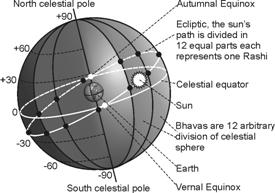
Fig 3.10 : Celestial sphere
Geo-centric view
As discussed earlier, in Vedic Jyotish (astrology), we are considering the effect of celestial bodies on an object, which is present on this Earth. That’s why now we will shift our focus on geocentric view rather than heliocentric. Refer to fig 3.11 Geo-centric view.

Fig 3.11 Geo-centric view
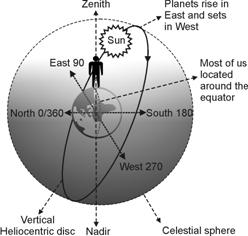
Fig 3.12 : Geocentric view from our perspective
Integration
Let’s integrate 12 Bhavas (arbitrary division of space around Earth), 12 Rashis (division of moving group of stars) and 9 Grahas (planets). Refer to fig 3.13 : Three layers of celestial sphere. From Earth’s perspective we have following 3 layers -
- First outer layer, the vertical 12 slices (30 degree each) of the celestial sphere is called Bhavas (arbitrary division of space around Earth). Refern to fig 3.10 : Celestial sphere.
- In the second middle layer, we have 12 Rashis (division of moving group of stars) and they move in the fixed Bhavas (arbitrary division of space around Earth). Pretend that you are standing on the Earth, in the center of celestial sphere. And imagine that all the Rashi (division of moving group of stars) are plastered up on the inside wall of celestial sphere. Refer to fig 3.13 : Three layers of celestial sphere.
- Third inner layer consist of our solar disc, consisting of 9 Grahas (planets). Grahas (planets) move in Bhavas (arbitrary division of space around Earth) and 12 Rashis (division of moving group of stars).
- Thus a fixed Bhava (arbitrary division of space around Earth) will always have a Rashi (division of moving group of stars) and may also have a Graha (planet) in it.
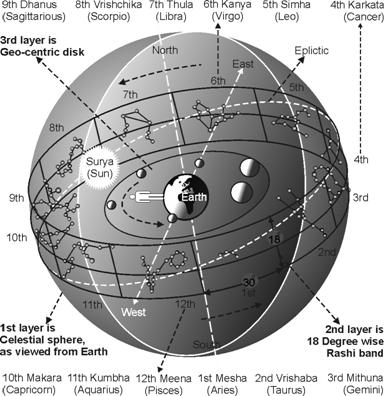
Fig 3.13 : Three layers of celestial sphere
At the beginning of every Rashi (division of moving group of stars), the degree gets initialized to zero. Thus the Grahas (planet) placement in the space is measured in degrees, minutes and seconds in a specific Rashi. For example, Bhraspati (Jupiter) is at 15 degree 0 minutes and 0 seconds in Mithuna (Gemini), where Mithuna (Gemini) is in the 10th Bhava (arbitrary division of space around Earth). Though from Bhava’s (arbitrary division of space around Earth) perspective, Bhraspati (Jupiter) is placed at about 285 degree 0 minutes and 0 seconds, which becomes 10th Bhava (arbitrary division of space around Earth). In Vedic Jyotish (astrology), most of the time, we don’t talk in terms of absolute degrees such as 285 degree 0 minutes and 0 seconds. Instead, we will say that Lagna is 6th Rashi (division of moving group of stars) and Bhraspati (Jupiter) is at 15 degree 0 minutes and 0 seconds in Mithuna (Gemini).Maping Universe to Kundali
Fig 3.15 : Top view of geo-centric disk, depicts the 12 Rashis (division of moving group of stars) sectors and Grahas (planets) placed in the Bhavas (arbitrary division of space around Earth).
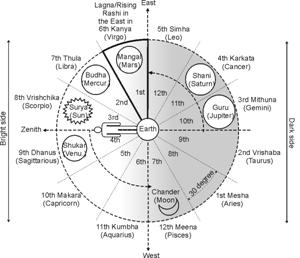
Fig 3.15 : Top view of geo-centric disk
Vedic Jyotish (astrology) Clock discussed in the last chapter and Kundali (horoscope) are basically the top view of the geocentric disk, where Earth’s North Pole is protruding towards us. Earth is in the center of the space, and space around Earth is divided into 12 equal parts, which are called Bhava (arbitrary division of space around Earth). Bhava (arbitrary division of space around Earth) are always stationary, like a dial of an analogue clock. Usually, Graha (planets) and Rashi (division of moving group of stars) move in these Bhava (arbitrary division of space around Earth) in an anticlockwise direction.
Fig 3.16 : Bhava, shows the base template of Kundali (horoscope). This diagram depicts 12 Bhavas (arbitrary division of space around Earth), which are fixed. Since Bhavas (arbitrary division of space around Earth) are fixed, they are not numbered in actual practice.
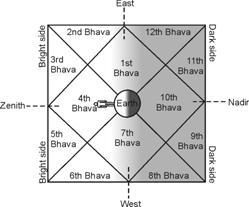
Fig 3.16 : Bhava
The snap shot shown in Fig 3.15 : Top view of geo-centric disk, is taken at the time of birth, in which Kanya (Virgo) was the rising Rashi (division of moving group of stars) in the East. This means that Kanya (Virgo) will fall in the 1st Bhava (arbitrary division of space around Earth), which is top middle box in Fig 3.16 : Bhava. Fig 3.17 : Bhava and Rashi, shows the mapping of Rashi’s (division of moving group of stars) in the Bhava.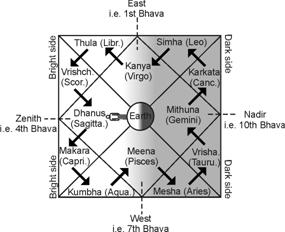
Fig 3.17 : Bhava and Rashi Name
Alternatively, we can also represent the Rashi’s (division of moving group of stars) with numbers. This is shown in fig 3.18 : Bhava and Rashi. Later in the book, we will use just numeric numbers to represent Rashi’s (division of moving group of stars).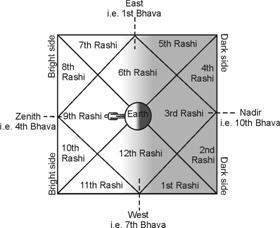
Fig 3.18 : Bhava and Rashi Number
Fig 3.19 : Kundali, depicts a complete Kundali (horoscope). It’s basically the superimpositions of 12 fixed Bhavas (arbitrary division of space around Earth), 12 Rashis (division of moving group of stars) and 7 Grahas (planets). Rahu (ascending node or dragon head) and Ketu (descending node or dragon Tail) are not shown in this diagram.
Lagna or rising Rashi (division of moving group of stars) is Makara (Capricorn) and is placed in 1st Bhava (arbitrary division of space around Earth). Graha (planet) Mangal (Mars) is in 1st Bhava (arbitrary division of space around Earth), Budh (Mercury) is in 2nd Bhava (arbitrary division of space around Earth), Surya (Sun) is in 3rd Bhava (arbitrary division of space around Earth), Shukar (Venus) is in 4th Bhava (arbitrary division of space around Earth), Chander (Moon) is in 7th Bhava (arbitrary division of space around Earth), Guru (Jupiter) in 10th Bhava (arbitrary division of space around Earth) and Shani (Saturn) in 11th Bhava (arbitrary division of space around Earth).
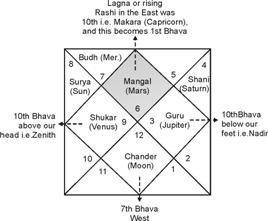
Fig 3.19 : Kundali
In fig 3.20, we have depicted the mapping of Universe to Kundali (horoscope), which is considered to be the key report in Vedic Astrology.
Fig 3.20 : Mapping of universe to Kundali
Types of Kundalis
Broadly, there are two types of Kundalis (horoscope) viz North and South Indian style. In this book, we will focus on North Indian style of Kundali (horoscope). Refer to fig 3.19 : South Indian style Kundali. In South India style of Kundali (horoscope) Rashi (division of moving group of stars) stays fixed and Lagna is indicated with a bar on the top right corner.
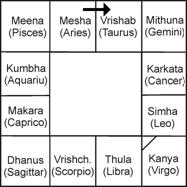
Fig 3.19 : South Indian style Kundali

